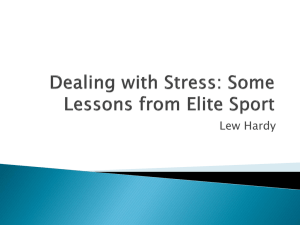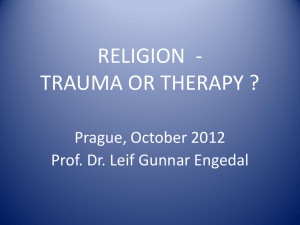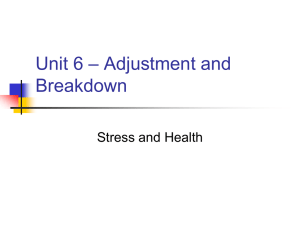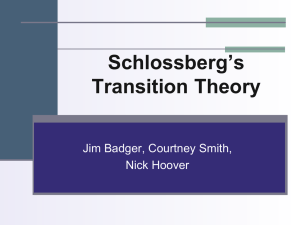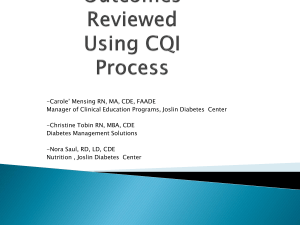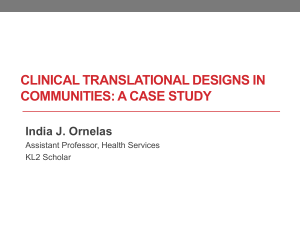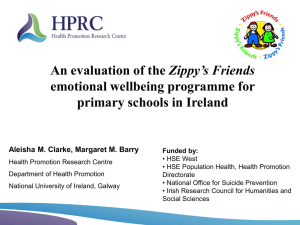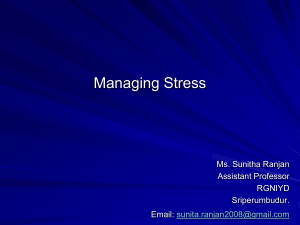Stress, Coping and Health
advertisement
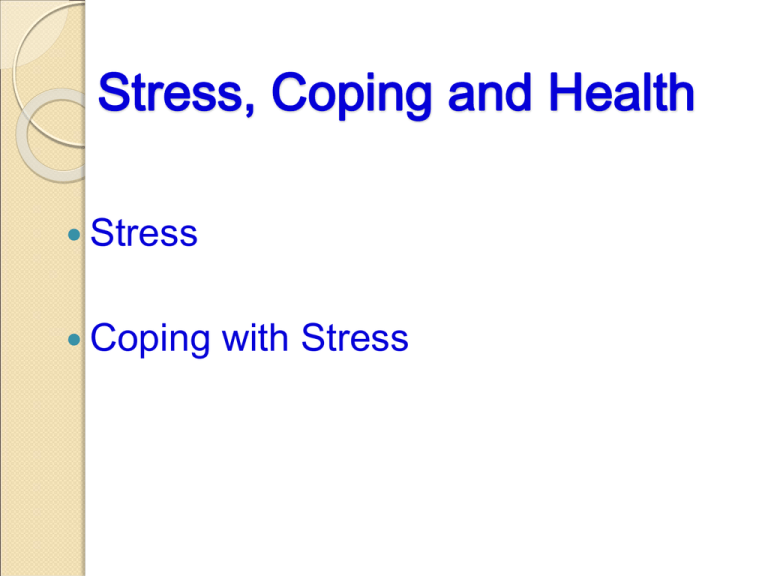
Stress, Coping and Health Stress Coping with Stress Stress, Coping and Health Stress is a major pathway through which psychosoical factors affect physiology and the aging process. Human are relatively resilient to the effects of stress that can reduce or buffer its effects. Psychosocial stress can have negative effects on a person’s cardiovascular and immune systems, or can have positive effects on a person’s growth, depending on temporal patterning and on how we cope with it. Stress Stress as A Physical State Stress as A Characteristic of the Environment Stress as A Transaction Between the Person and the Environment. Stress Stress as A Physical State (3 definitions, Mason, 1975) Stress – a physiological state of the organism. Stress – a characteristic of the environment (stressor). Stress – a transaction between the person and environment. Stress as a Physical State Classic theory Cannon (1915) coined the term the “Fight or flight” response that is commonly used to describe the way in which our body reacts to stress. Cannon posited that the perception of a threat activated the sympathetic nervous system (SNS), which readies the organism for fight or flight through hypothalamus that responds to stress. Stress as a Physical State (cont) Classic theory (two types of responses, Gevirtz 2000) 1. The sympathetic nerves directly enervate the heart, the bronchi in the lungs, the gut, and the kidney, and also influence the blood vessels, sweat glands, and piloerector muscles, a short and fast time response. 2. Through sympathetic/adrenal medulla (SAM) system, the sympathetic nerves radiate to the adrenal medulla which secretes both epinephrine and norepinephrine into the blood, which stimulates the organs’ muscles. The routine through the medulla can last up to 10 times longer than the direct enervation in Figure 10.1. Stress as a Physical State (cont) Cannon (1929) argued that this fight/flight reaction, although adaptive in the short run, could have very harmful effects if prolonged. It is not only humans who can be frightened to death, this fairly common problem among animals, example on pages 258-259. Stress as a Physical State (cont) Selye (1956) expanded on Cannon’s conceptions in two ways: 1. Corticosteriods, released by the adrenal cortex are also elevated in response to a wide variety of stressor. The hypothalamic-pituitaryadrenal (HPA) activation – a slower but more sustained response (Figure 10.2). 2. Three stages in reaction to stress in Figure 10. 3 fight or flight responses. Figure 10. 3 The Fight or Flight Response Stress as a Physical State (cont) Modern theories: There are individual differences in stress responses in the patterning of sympathetic arousal, Ex. some individuals’ heart rates increased in response to stress, but others’ heart rates decreased. Most of the endocrine hormones are affected by stress. Taylor et al. (2000) showed that men and women differ in their preference for company or solitude while awaiting a stressful procedure. Fight-flight-affiliate, a three-dimensional response to stress in Figure 10.3. Stress as a Physical State (cont) Stress and the development of chronic illness. Studies in animal models show that stress can result in heart disease (Kaplan et al., 1996), and breast cancer (Ader et al., 1991). Modern life is full of stress because of many factors cardiovascular system is more prone to be affected by stress. Hypothalamus--pituitary--adrenal axis is activated by stress and stress elicits changes in sympathetic - parasympathetic balance, which might negatively affect the cardiovascular system (Kumar, 2008). Stress as a Physical State (cont) Positive physiological Changes: In animal research, infant mice and rats subject to mild electric shock or handling matured more quickly than their nonstressed peers. They develop hair and opened their eyes early, has better locomotion and reached puberty younger ages. In human research, adults are taller when they are subjected to stressors in the first 2 year (infants) of life, childhood stress is related to earlier puberty, and stress can induce physiological toughness if it is followed by an adequate recovery period. Stress as a Physical State (cont) Physiological stress and aging In aging rats, the response degrade – there is a much slower increase in cortisol, and it takes much longer to return to baseline. In humans, age-related changes in the stress response are quite variable and somewhat contradictory. Sedentary middle-aged men who suddenly undertake strenuous physical labor are vulnerable to heart attacks. Stress as a Characteristic of the Environment Trauma: Traumatic stress – direct personal experience of an event that involved serious of threat to the life or physical integrity of self or significant others. About 20-30% of traumatic victims develop PTSD. PTSD – characterized by affective disturbances including anxiety, depression, suicidal ideas, startle reactions, nightmares, and flashbacks. POWs and torture victims have had high rates of PTSD (50%). Stress as a Characteristic of the Environment (cont) Stressful life events They are major disruptions in individuals’ lives due to specific occurrences such as marriage, divorce, widowhood, and job loss. Negative life events tend to show modest correlations (r = 0.2 or 0.3) with self-reported mental and physical health outcomes, and positive life events show little relationship to health outcomes. Stress as a Characteristic of the Environment (cont) Chronic role strain – enduring problems linked to social roles such as marriage, work, parenting, finances, and health. Life events have adverse effects on physical and mental health because they cause disruptions in ongoing relations with spouses, children, jobs, and/or finances (Pearlin et al., 1981). Pearlin et al. (1996) argued that a chronic role strain becomes stressful when it spreads to another domain, a phenomenon termed “stress proliferation”, example of caregiver on page 270. Stress as a Transaction between the Person & Environment Psychosocial stress and aging: Stress arises from a combination of environmental demands and individual vulnerabilities and resources. Types of stress change with age, people in the midlife more likely to report problems with children and work, whereas older adults re more likely to report problems with health and retirement (Aldwin et al., 1996). Age-related changes in the appraisal of stress. Older people may be less likely to appraise a situation as stressful. Why? (page 273). Coping with Stress Theoretical Approach to Coping 1. Defense Mechanisms 2. Personality-based Coping Styles 3. Coping as a Process Defense Mechanisms Defense Mechanisms - are unconscious psychological strategies brought into play by various entities to cope with reality and to maintain self-image. Healthy persons normally use different defenses throughout life. An ego defense mechanism becomes pathological only when its persistent use leads to maladaptive behavior such that the physical and/or mental health of the individual is adversely affected. The purpose of ego defense mechanisms is to protect the mind/self/ego from anxiety, social sanctions or to provide a refuge from a situation with which one cannot currently cope. Defense Mechanisms (cont) Freud proposed three structures of the psyche or personality: Id: a selfish, primitive, childish, pleasure-oriented part of the personality with no ability to delay gratification. Superego: internalized societal and parental standards of "good" and "bad", "right" and "wrong" behavior. Ego: the moderator between the id and superego which seeks compromises to pacify both. It can be viewed as our "sense of time and place“. Defense Mechanisms (cont) In Vaillant's (1977) categorization, defenses form a continuum related to their psychoanalytical developmental level: Level I - pathological defenses (i.e. psychotic denial, delusional projection, ex on page 274) Level II - immature defenses (i.e. fantasy, projection, passive aggression, acting out) Level III - neurotic defenses (i.e. intellectualization, reaction formation, dissociation, displacement, repression) Level IV - mature defenses (i.e. humor, sublimation, suppression, altruism, anticipation, ex of MADD on 275). Coping Styles Coping styles – is a person's characteristic strategies used in response to life problems or traumas. These can include thoughts, emotions or behaviors. Ex, Women tend to have a ruminative coping style, mulling their problems over internally, while men tend to use distracting strategies in a effort to forget their problems. http://depression.about.com/od/glossaryc/g/coping_styl e.htm Environmental and personality factors play a role in coping (Schwarz & Daltroy, 1999). Coping Processes Coping processes – intentional conscious strategies, Ideally, individuals monitor the outcomes of their strategies and modify them to achieve their goals in the situation. Five types of coping processes: 1. Problem-focused coping – cognitions and behaviors for managing a problem. 2. Emotion-focused coping – expressing or avoidance emotions. 3. Social support – asking for advice, help and aid. 4. Religious coping – praying and asking for help. 5. Making meaning – making sense of the problem and/or reinterpreting it. Coping and Physical Health Coping generally has positive effects, but could have negative effects. See three models as follows: 1. Coping may have direct effects on health on page 277. Coping may affect the progression of illness, ex, teaching good coping skills helps immune function and greater longevity with melanoma patients. 2. Coping and health outcome – assuming a positive effect. 3. The contextual model – the effects of coping may vary as a function of situational variables such as type or severity of illness, ex on page 278. Coping and Aging Gutmann (1974) reported that older individuals become more passive copers. Some (Aldwin, 1991) reported that older adults used fewer escapism or avoidant coping strategies, some (Folkman et al., 1987) reported that older adults used more escape avoidance. Labouvie-Vief et al. (1989) suggested that both cognitive and emotional complexity increase with age, which influences the way older individuals both appraise and copy with stress. What are your thoughts about “coping and aging”?

